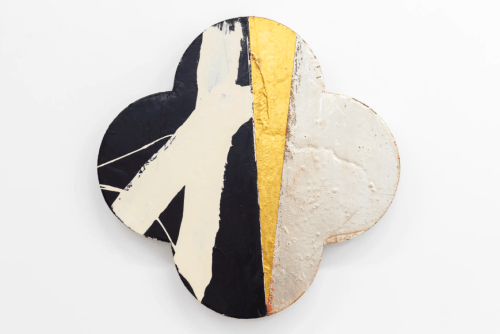
There sometimes appears to be many Gimbletts: one is an extroverted colourist, another pursues the subtle luminous effects of gilded and lacquered surfaces. Gimblett brushes with all things: sacredness and passion; violence, sacrifice, and death; fear and awe; beauty, pleasure, peace, and joy.
—Wystan Curnow, Max Gimblett: The Brush of all Things, Auckland Art Gallery, 2004
This exhibition is not intended as a survey, rather an opportunity to consider an archive of works made over a period of more than thirty years. Many of these works have never been shown, instead carefully tucked away, waiting for the right moment.. Each work captures something of a particular time; while tracing gestures, forms, colours, and theories that Max Gimblett has returned to throughout a decades long practice. Collectively, these works reflect the many lives and legends that surround the artist.
Born in Auckland Tāmaki Makaurau in 1935, and based in New York since 1972, Max Gimblett has long been devoted to the notion of the archive. The Getty Research Institute recently acquired an anthology of over 250 of the artist’s books, gifted by the artist and his wife, scholar, and curator Barbara Kirshenblatt-Gimblett.
“I’ve been making [these books] since 1963. There are some I’ve worked in for fifty plus years and they are astonishing. Travel journals, sketchbooks, journals, artist’s books made in collaboration with amazing poets and writers, other painters ... These books are made up of ink drawings, collages, gilding with precious metals, and stampings and have been bound by four different bookbinders over the years,” says Gimblett.
The exhibition takes its title from The Legend of the Ceramic Master, which speaks to a defining period in the artist’s life. The work acknowledges Ukrainian Canadian ceramic artist Roman Bartkiw, who twenty-seven-year-old Gimblett visited at his Toronto workshop in 1962, immediately agreeing to a two-year apprenticeship. It was the following year that Gimblett met his future wife, who was instrumental in Gimblett first identifying himself as an artist. The couple soon moved to San Francisco where Gimblett studied painting at the San Francisco Art Institute while Kirshenblatt completed a BA and an MA at the University of California, Berkeley before they eventually arrived in New York via Bloomington Indiana, and Austin, Texas.
Gimblett quickly established a studio and the couple immersed themselves in the bustling New York art scene, living and working in The Bowery on the Lower East Side, a refuge to many artists and artist studios. In a recent publication documenting the history of the area, the couple reflected on their forty-four years there, writing “The Bowery was a paradox, at once victim and beneficiary of the city’s downturn. Undaunted by the dangers of the neighbourhood, artists moved into lots left vacant by manufacturers who had left the city.”
All the works in the exhibition were born of this setting. Some make broader allusions to religion, death, and spirituality; embodying a certain heroism not only in scale but in the resplendent gilding of precious metals, lending the works an alchemical connection to the divine. Others further reference personal biography and significant figures who have influenced the artist, including Sōtō Zen priest Great Dragon Michael Wenger, who gifted Gimblett his own personal zen kōan or statement; “at every step the pure wind rises.” Spirituality has long been essential to Gimblett. A long-time practitioner of Buddhism, Gimblett took his vows as a Rinzai Zen priest in 2006. “I believe in karma. I believe that I’ve had many lives, and this is a result of those. This life is an accumulation.”